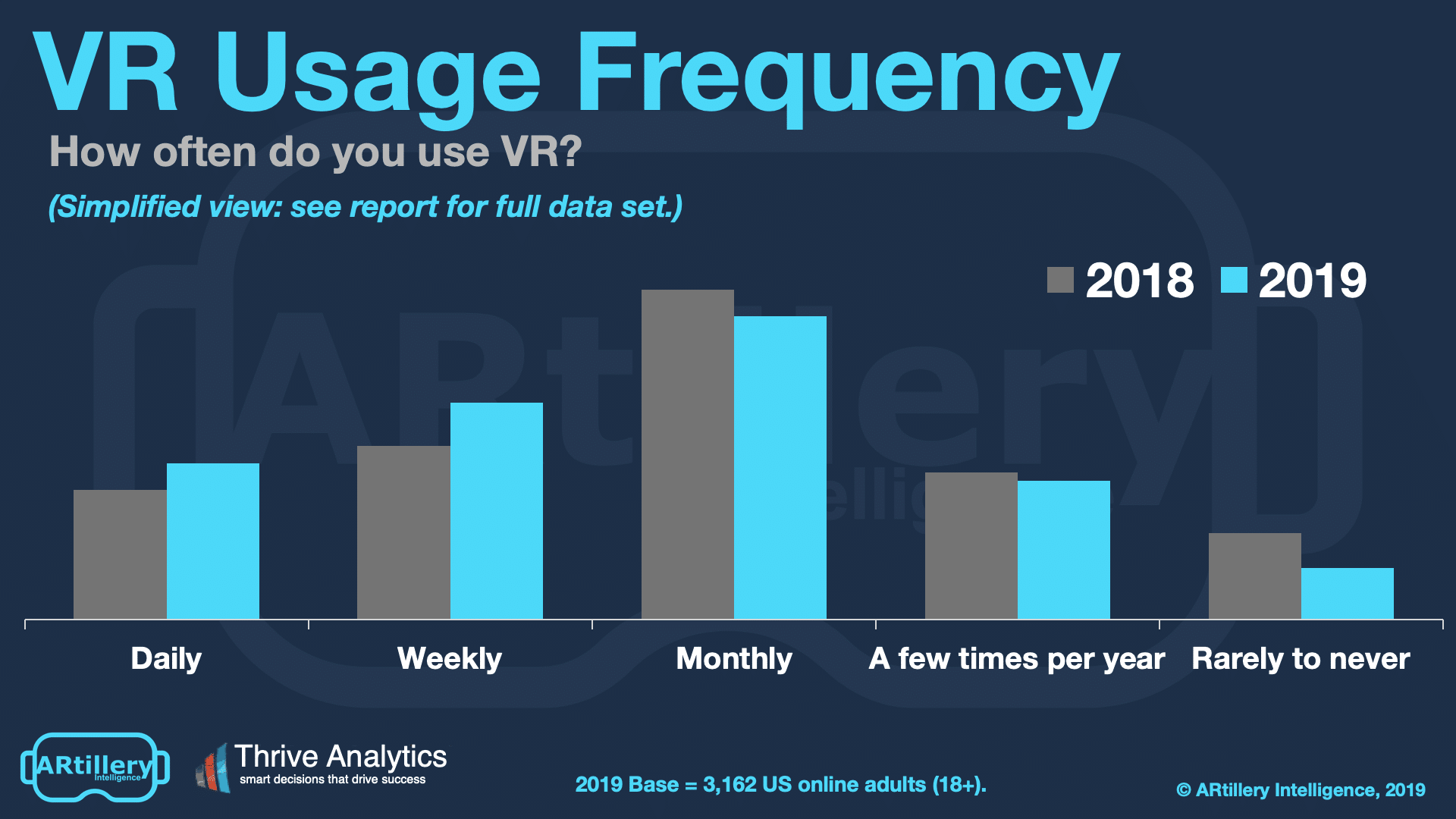
ARtillery Briefs is a video series that outlines the top trends we’re tracking, including takeaways from recent reports and market forecasts. See the most recent episode below, including narrative takeaways and embedded video.
There are a lot of questions being asked about VR. Who’s using it? What experiences resonate most? So we set out for answers. Working with Thrive Analytics, ARtillry Intelligence authored questions to be fielded through its established survey engine to more than 3000 U.S. adults.
The result is wave III of Thrive’s Virtual Reality Monitor, as well as a narrative report written by ARtillery Intelligence to unpack the results and strategic implications. It’s also the subject of the latest episode of AR Briefs, which you can see embedded at the bottom of this post.

The Good News
Starting at the top, what did we find out? First, 16 percent of respondents have used or own a VR headset, which is up from 11 percent in 2018. More importantly, they’re doing it often. Specifically, 78 percent of users engage monthly or more, while 22 percent do so monthly or less.
This is key for VR given that adoption barriers can be high with setup and overall technological invasiveness. So the name of the game is ease of use and replayability, which will continue to improve with the growth in standalone headsets that reduce friction, like Oculus Go and Quest.
Users also indicate high levels of satisfaction with VR experiences that they’ve tried. Specifically, 67 percent reported extreme or moderate satisfaction with VR. Only 4 percent are dissatisfied. Like the frequency metric above, this indexes high compared to other consumer technologies.

Content is King
As for other adoption drivers, it’s all about content and price. Content especially has been a common theme so far in all three waves of this study. But interestingly, content availability now isn’t as much of a concern as it was in wave II, which we attribute to content efforts of Oculus.
That includes Oculus Go’s backward-compatibility with Gear VR’s library which gives it 1000 compatible apps. This will improve further with Oculus Quest, given its 50 launch titles, 100 games projected by year end, and the Youtube app that gives it access to one million 360 videos.
As for experiences that users are most interested in, cinematic content is in the lead, followed by gaming and travel. Cinematic’s lead is somewhat surprising because it involves watching 2D video in a 3D environment, which isn’t native to VR (though it’s where Go shines).
The lesson here is that with such a nascent and unproven technology, users want what they’re most comfortable with, even though it’s not the best form of VR. It will continue to be conceptualized in activities consumers know, until more native VR reframes their thinking.

Seeing is Believing
As for price sensitivity, demand seems to inflect at $400 and $200. These are interestingly the price points for Oculus headsets including Quest, Rift S and GO. This pricing strategy has given Oculus an edge (and accelerated its market share) in the early and price-sensitive VR market.
Oculus’ aggressive pricing essentially subsidizes hardware, pursuant to its long-game platform strategy. Platform wars are often won with early momentum and network effect, which involves incentivizing developers and users that otherwise get stuck in a chicken & egg dynamic.
Speaking of which, what about non-VR users? They report low interest at 27 percent of respondents, down from 31 percent last year. When compared to the above high satisfaction for VR users, this raises a key disparity, and a challenge for VR: you have to see it to believe it.
In other words, to reach those high satisfaction levels, VR has to first be tried. This presents marketing and logistical challenges for the industry to push that first taste, given a medium that can’t really be captured in words or video. It’s like “selling TVs on the radio” as we like to say.

The bottom line is that it will take time, acclimation and price reductions before VR reaches a more meaningful share of the consumer public. There’s of course a lot more to it, and you can see more extensive data in the full report, including per-headset usage breakdowns and other results.
Meanwhile the high-level takeaway is that VR’s growth will be driven by continued downward pricing pressure, lots more content, and the lowered friction brought by standalone headsets. All of these events will collectively push VR forward… but it will be a gradual process.
See the latest episode of AR Briefs below for more
For deeper XR data and intelligence, join ARtillery PRO and subscribe to the free AR Insider Weekly newsletter.
Disclosure: AR Insider has no financial stake in the companies mentioned in this post, nor received payment for its production. Disclosure and ethics policy can be seen here.
